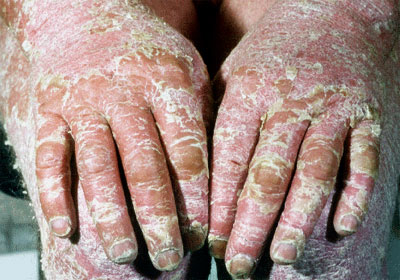|
|
|
Erythrodermic psoriasis
Erythrodermic psoriasis is a generalization of psoriasis vulgaris or pustular psoriasis.
Scaling is present but not normally the thick micaceous scales typical of psoriasis vulgaris. The skin can be bright red to salmon pink. There may be fever, malaise and adenopathy.
Erythrodermic psoriasis is a serious exacerbation of psoriasis vulgaris.
Heat regulation is difficult, and the skin is prone to infection.
Its etiology can include an irritation that worsens typical psoriasis. Irritating compounds include psoriatic treatments such topical anthralin, or a sunburn resulting from excessive UVB or PUVA therapy. Exacerbation of psoriasis vulgaris can also be caused by the beta blockers.
Treatment:
- An important point in management is not to irritate the skin further.
- Anthralin and other irritating compounds are relatively contraindicated in erythrodermic psoriasis.
- Bland topical steroids such as 1 % hydrocortisone in an ointment base applied liberally can be helpful.
- If there is not a reasonably rapid improvement, consideration should be given to the use of cyclosporine 2 to 5 mg/kg/per dose or methotrexate 5 mg, q 12 hours for 3 doses, once weekly.
- When the acute episode has subsided, UVB or PUVA can usually be carefully restarted.

Back to Dermatology Glossary - E Index |
Back to Dermatology Glossary Index
|